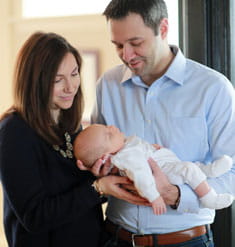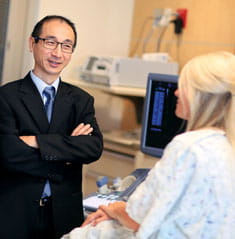Tireless Pursuit
Researchers at Cincinnati Children's are Searching for Answers to Medicine's Biggest Questions
Liz and David Vitale will never receive satisfying answers to the questions that will always haunt them. Why us? Why Caroline?
Doctors explained what happened to their daughter, Caroline. Her lungs stopped developing on a microscopic level when Liz was only 15 weeks pregnant. Doctors gave the condition a name — congenital alveolar dysplasia.
Most painful of all, they told Liz and David how many cases of this condition had been recorded before Caroline. Fifteen. That’s worldwide. Just fifteen.
Little Caroline lived for 24 days. For most of them, she was connected to a machine that kept her alive. She never took a good, deep breath of air. She never cried like other babies.
“That was really hard, to learn how rare her condition was,” says Liz, stopping short. One year later, talking about Caroline still hurts. “It didn’t seem fair. We just wanted to know, why us?”
Asking Big Questions
Cincinnati Children’s is driven by questions. Big questions. How can we help babies like Caroline? What will it take to cure the rarest diseases? How can we comfort families in their darkest hours.
We’re committed to finding the answers to these questions. We’ve dedicated 1.4 million square feet of space to laboratories and research facilities, making Cincinnati Children’s one of the largest pediatric research centers in the world. Every day, our doctors and researchers draw a little closer to answering complex questions.
All that research culminated in several exciting discoveries last year. In 2017, our faculty published four articles in the New England Journal of Medicine (NEJM), the most prestigious peer-reviewed medical journal in the country.
“Our commitment to research comes from our commitment to patients,” says Peggy Hostetter, MD, director of the Cincinnati Children’s Research Foundation. “And our researchers’ success in publishing so many noteworthy articles shows how hard they’re working to improve outcomes for every child.”
Understanding Preterm Birth
At Cincinnati Children’s, triumph exists side by side with tragedy. Our doctors cared for Caroline with intensity and insight. In her case, there was nothing they could do. But those same qualities have allowed us to make breakthroughs for other patients.
Louis Muglia, MD, PhD, co-director of our Perinatal Institute, was one of the doctors whose work was featured in the NEJM last year. He led an international group of researchers to uncover genes linked to preterm birth, the leading cause of infant death. Any insight into its causes could save thousands of babies every year.
“This study has the potential to transform the way we care for pregnant women,” says Dr. Muglia. “Because of the discoveries we’ve made, we can find new ways to give babies a better start in life.”
Dr. Muglia is quick to point out the collaborative nature of his research.
“The advances we’ve been able to achieve take the partnership of many—researchers, doctors, each contributing their own expertise. It also requires philanthropy. We can’t undertake big projects without committed donors,” he says.
Advancing Research, Helping Others
For Liz and David, nothing will ever completely fill the void left by Caroline’s brief life. But their experience has not left them hopeless. As condolences from friends and family poured in, they decided to redirect that support to Cincinnati Children’s.
They established the Caroline Clay Vitale Memorial Fund to support research into what are known as “orphan” diseases.
“Some diseases are so rare that there’s no support network for families touched by them,” says David, who is a clinical fellow in our Division of Gastroenterology, Hepatology and Nutrition. “There just aren’t any groups out there raising money to fund research into conditions as rare as Caroline’s.”
The money that Liz and David have raised—more than $50,000—will support research into these rare diseases. The research is overseen by Foong-Yen Lim, MD, surgical director of our Cincinnati Fetal Care Center and one of Caroline’s primary doctors while in our care. Liz and David say it was thanks in large part to Dr. Lim’s compassion and dedication that they made it through those 24 days.
The fund also provides for autopsies and genetic testing for families who lose their child to unknown causes while at our medical center. These services can pinpoint the exact cause of death when a rare disease is suspected, bringing closure for families. The tests can also help parents determine the risks involved in conceiving another child.
Hope for the Future
Sixteen months after Caroline’s passing, Liz and David celebrated the birth of their son, Samuel. He’s healthy, strong and—to his parents—perfect in every way. Each time Liz holds him in her arms, she’s overwhelmed by love and gratitude.
“It’s easier now to focus on all the good things that happened while Caroline was in the intensive care unit,” Liz says. “The amazing nurses. Dr. Lim and the care he provided. We can be grateful for those things.”
For his part, Dr. Lim is grateful that Liz and David are enabling him to advance research that will help other families.
“I’m so thankful for the support they’ve provided,” he says. “They’re giving hope to others.”
David knows that the field of medicine is always evolving. He and Liz will always have questions about Caroline, but researchers like Dr. Lim will never stop searching for answers.
“This is how we want people to remember Caroline,” says David. “By advancing research to help answer questions for other families, and give them hope.”
To support newborn research and care at Cincinnati Children's, contact Jennie Parker at 513-636-1118 or jennie.parker@cchmc.org.





